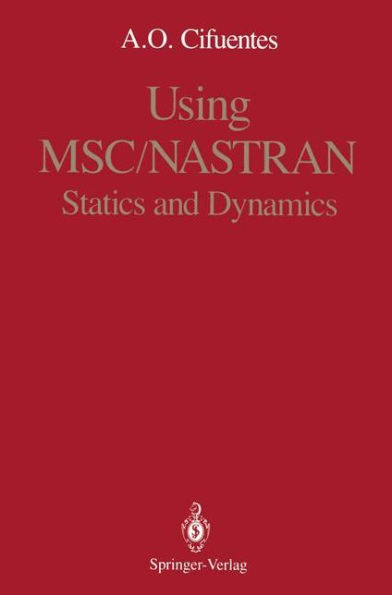Table of Contents
Basic MSC/NASTRAN concepts.- 1 Statics.- Problem 1.- 1.1 Statement of the problem.- 1.2 Cards introduced.- 1.3 MSC/NASTRAN formulation.- 1.4 Input Data Deck.- 1.5 Results.- Problem 2.- 2.1 Statement of the problem.- 2.2 Cards introduced.- 2.3 MSC/NASTRAN formulation.- 2.4 Input Data Deck.- 2.5 Results.- Problem 3.- 3.1 Statement of the problem.- 3.2 Cards introduced.- 3.3 MSC/NASTRAN formulation.- 3.4 Input Data Deck.- 3.5 Results.- Problem 4.- 4.1 Statement of the problem.- 4.2 Cards introduced.- 4.3 MSC/NASTRAN formulation.- 4.4 Input Data Deck.- 4.5 Results.- 4.6 Additional comments.- Problem 5.- 5.1 Statement of the problem.- 5.2 Cards introduced.- 5.3 MSC/NASTRAN formulation.- 5.4 Input Data Deck.- 5.5 Results.- Problem 6.- 6.1 Statement of the problem.- 6.2 Cards introduced.- 6.3 MSC/NASTRAN formulation.- 6.4 Input Data Deck.- 6.5 Results.- Problem 7.- 7.1 Statement of the problem.- 7.2 Cards introduced.- 7.3 MSC/NASTRAN formulation.- 7.4 Input Data Deck.- 7.5 Results.- 7.6 Additional comments.- Problem 8.- 8.1 Statement of the problem.- 8.2 Cards introduced.- 8.3 MSC/NASTRAN formulation.- 8.4 Input Data Deck.- 8.5 Results.- Problem 9.- 9.1 Statement of the problem.- 9.2 Cards introduced.- 9.3 MSC/NASTRAN formulation.- 9.4 Input Data Deck.- 9.5 Results.- Problem 10.- 10.1 Statement of the problem.- 10.2 Cards introduced.- 10.3 MSC/NASTRAN formulation.- 10.4 Input Data Deck.- 10.5 Results.- Problem 11.- 11.1 Statement of the problem.- 11.2 Cards introduced.- 11.3 MSC/NASTRAN formulation.- 11.4 Input Data Deck.- 11.5 Results.- Problem 12.- 12.1 Statement of the problem.- 12.2 Cards introduced.- 12.3 MSC/NASTRAN formulation.- 12.4 Input Data Deck.- 12.5 Results.- Problem 13.- 13.1 Statement of the problem.- 13.2 Cards introduced.- 13.3 MSC/NASTRAN formulation.- 13.4 Input Data Deck.- 13.5 Results.- 2 Dynamics.- Problem 14.- 14.1 Statement of the problem.- 14.2 Cards introduced.- 14.3 MSC/NASTRAN formulation.- 14.4 Input Data Deck.- 14.5 Results.- Problem 15.- 15.1 Statement of the problem.- 15.2 Cards introduced.- 15.3 MSC/NASTRAN formulation.- 15.4 Input Data Deck.- 15.5 Results.- Problem 16.- 16.1 Statement of the problem.- 16.2 Cards introduced.- 16.3 MSC/NASTRAN formulation.- 16.4 Input Data Deck.- 16.5 Results.- Problem 17.- 17.1 Statement of the problem.- 17.2 Cards introduced.- 17.3 MSC/NASTRAN formulation.- 17.4 Input Data Deck.- 17.5 Results.- Problem 18.- 18.1 Statement of the problem.- 18.2 Cards introduced.- 18.3 MSC/NASTRAN formulation.- 18.4 Input Data Deck.- 18.5 Results.- Problem 19.- 19.1 Statement of the problem.- 19.2 Cards introduced.- 19.3 MSC/NASTRAN formulation.- 19.4 Input Data Deck.- 19.5 Results.- 19.6 Additional comments.- Problem 20.- 20.1 Statement of the problem.- 20.2 Cards introduced.- 20.3 MSC/NASTRAN formulation.- 20.4 Input Data Deck.- 20.5 Results.- Problem 21.- 21.1 Statement of the problem.- 21.2 Cards introduced.- 21.3 MSC/NASTRAN formulation.- 21.4 Input Data Deck.- 21.5 Results.- 3 A Few Modeling Tips.- Problem 22.- 22.1 Statement of the problem.- 22.2 Cards introduced.- 22.3 MSC/NASTRAN formulation.- 22.4 Input Data Deck.- 22.5 Results.- Problem 23.- 23.1 Statement of the problem.- 23.2 Cards introduced.- 23.3 MSC/NASTRAN formulation.- 23.4 Input Data Deck.- 23.5 Results.- Problem 24.- 24.1 Statement of the problem.- 24.2 Cards introduced.- 24.3 MSC/NASTRAN formulation.- 24.4 Input Data Deck.- 24.5 Results.- Problem 25.- 25.1 Statement of the problem.- 25.2 Cards introduced.- 25.3 MSC/NASTRAN formulation.- 25.4 Input Data Deck.- 25.5 Results.- Problem 26.- 26.1 Statement of the problem.- 26.2 Cards introduced.- 26.3 MSC/NASTRAN formulation.- 26.4 Input Data Deck.- 26.5 Results.- 26.6 Additional comments.- Problem 27.- 27.1 Statement of the problem.- 27.2 Cards introduced.- 27.3 MSC/NASTRAN formulation.- 27.4 Input Data Deck.- 27.5 Results.- 27.6 Additional comments.- Problem 28.- 28.1 Statement of the problem.- 28.2 Cards introduced.- 28.3 MSC/NASTRAN formulation.- 28.4 Input Data Deck.- 28.5 Results.- 28.6 Additional comments.- Appendix I List of Solution Sequences Demonstrated in the Text.- Appendix II Description of Selected Bulk Data Deck Cards.- Appendix III Selected Options for Output Request.- Appendix IV Selected Options for Contour Plots.- Appendix V Use of Static Loads in Dynamic Analysis.- Appendix VI Summary of Topics Covered in Each Problem.



